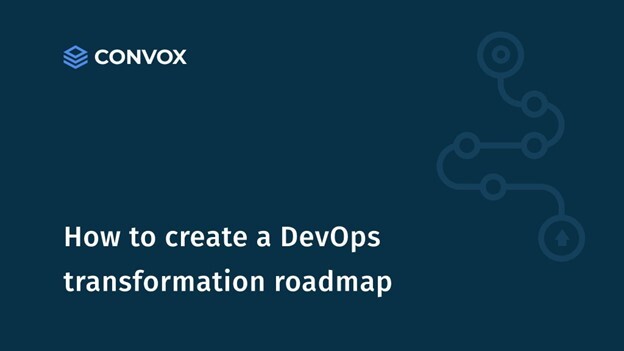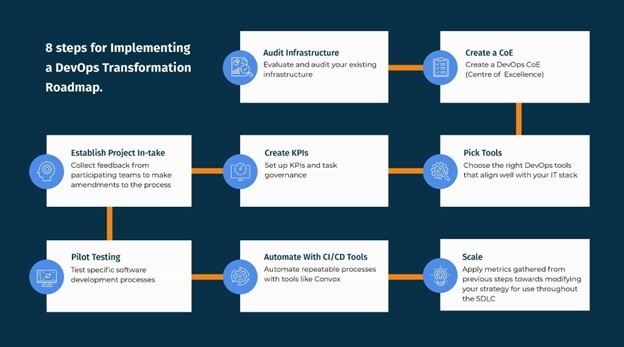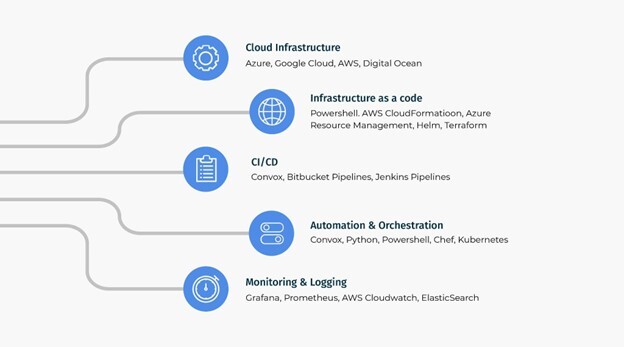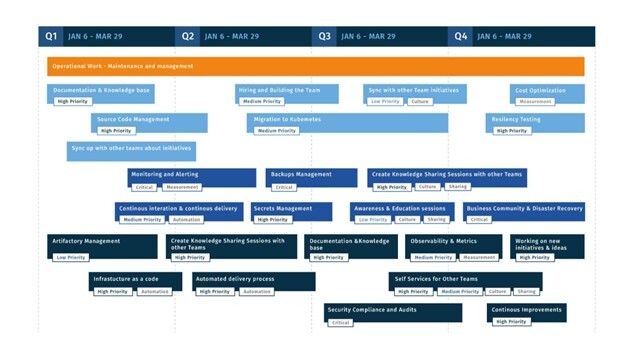
Do CIOs need a Roadmap for DevOps Transformation?
In 2023, organizations are striving to streamline and accelerate their release cycles for better ROI. To do this effectively, embracing a DevOps approach is a must, even though the process can initially feel overwhelming. However, with a proper roadmap and strategies in place, implementing a DevOps transformation exercise can be successful.
A DevOps culture promotes seamless collaboration between software development and operations teams from the onset of the SDLC. Compared to the traditional siloed approach, this collaborative approach speeds up the release cycle drastically, with fewer errors down the line.
But how can organizations successfully implement a DevOps transformation exercise that helps them reap these benefits?
A DevOps transformation roadmap is the answer.
What is a DevOps transformation roadmap?
A successful DevOps transformation project requires a strategic, well-thought plan or ‘roadmap.’ A roadmap with an agile CI/CD model helps CIOs get a better perspective of the transformation project. In addition, a DevOps transformation roadmap will also help team members:
-
Prioritize objectives
-
Break workflows into smaller chunks and shorter-term goals
-
Ease collaboration between development and operations teams
-
Assign and manage resources judiciously
-
Stay organized and avoid replicating processes, tasks, and objectives
-
Speed up time-to-market
-
Facilitate regular and frequent releases
-
Promotes early error detection and recovery
8 Steps for Implementing a DevOps
Transformation Roadmap:

The entire process of creating a DevOps roadmap can be divided into eight steps for a hitch-free execution.
1. Audit your Infrastructure
Before beginning your DevOps transformation journey, you must evaluate and audit your existing infrastructure. Assess the best tools for automating your deployments, your current team culture, strategies, processes, collaboration approach, etc., to help you understand your firm’s capacity to manage and sustain the new way of working.
This information will guide your technical team better toward the DevOps transformation process.
2. Create a DevOps CoE (Center of Excellence)
After the initial audit and evaluation, you must create a DevOps CoE responsible for collecting, documenting, collaborating, and sharing critical information related to your DevOps strategy. This will delineate and standardize the best DevOps practices to be implemented by all teams.
The main objective of setting up a CoE is to boost DevOps implementation performance to achieve faster TTM (time-to-market) for your software products.
3. Choose optimal DevOps tools
Today, you will find many top-class DevOps implementation tools in the market that make it easier to set up, test, and deploy software. However, the varied options available can become overwhelming to choose from.
To implement a practical DevOps roadmap, you must choose the right tools that align well with your IT stack. This will help you build customized processes and robust access controls to create a powerful infrastructure. The right DevOps tools will also help you deliver a pleasant user experience.
4. Set up KPIs and task governance
At the onset of your DevOps transformation roadmap, establish business-centric KPIs that contribute to your project’s success. Critical KPIs include time and frequency of deployment, change volume, mean time to failure, mean time to detect and recover, change failure rate, lead time, early failure detection, client feedback, automated testing models, SLAs, and so on.
A well-thought-out, strategic transformation roadmap will help meet these KPIs seamlessly. For this, streamlined communication between teams is vital - along with clearly defined roles, responsibilities, and priorities.
5. Establish project in-take
With a well-defined project in-take process, your team can improve the efficiency and speed of software development processes. Your selected DevOps development techniques and tools must be well-communicated to all the participant teams. Also, collect feedback from these teams to help your teams make informed amendments where necessary.
6. Pilot testing
This crucial step involves testing a specific software development process to evaluate how well it operates in the DevOps pipeline. You can choose a scalable model here and scale to the enterprise level later in the process.
During piloting, newly set up DevOps tools, techniques and practices are applied to the deployment pipeline. New KPIs are then compared and analyzed against the current ones to look for enhancement in performance.
7. Automate with CI/CD Tools
CI (Continuous Integration) and CD (Continuous Delivery) are two core processes that define a thriving DevOps culture, as they facilitate continuous improvement. CI involves continuously merging the code changes into the core repository. On the other hand, CD seamlessly distributes your software product for testing, staging, and production. Automated CI/CD helps you keep up with the growing customer needs while retaining product quality.
8. Scaling to the enterprise level
KPIs, feedback, and information gathered in the above step are further used to apply the newly tested DevOps transformation strategy to the entire SDLC. Frequent feedback and KPI analysis provide the necessary metrics to continuously modify the pipeline for increased efficiency.
Four cost-saving strategies for your DevOps Implementation Roadmap
Enterprises need to employ proper measures for cost optimization, as it is one of the main objectives of DevOps culture. Here are the top 4 cost-saving strategies you could implement for your DevOps strategy roadmap:
1. Partner with third-party services
Industry-leading cloud providers like Microsoft Azure, AWS, GCP, etc., provide top-notch cloud-based capabilities that DevOps experts can leverage. Your selected deployment tools should integrate well with all the major cloud service providers as these services can help to streamline your DevOps processes. Besides, you do not have to manage or customize these DevOps services, as CSPs handle this.
The best thing about third-party cloud services is that you can use them immediately after payment. Leveraging third-party services is cost-effective as they eliminate the time and complexity of building from scratch. They also provide insight and valuable metrics that can prove resourceful to DevOps teams. However, if you still wish to develop a custom cloud solution for a specific business model, DevOps experts can help you integrate these with your third-party services.
2. Automate infrastructure provisioning and CI/CD workflows:
Continuous delivery is critical to the DevOps roadmap for transforming development and operations teams, processes, and technology to keep software delivery toolchains efficient, seamless and reliable.
Infrastructure as Code (IaC) methodology and practices provide development teams with IT infrastructure and CI/CD workflows based on frameworks and templates.
DevOps transformation is a complicated process as it merges all branches of the SDLC. Teams involved must have expertise in the tools and technologies used. Whether you partner with a DevOps expert or create your own DevOps team from scratch, your solution must be well-versed in the following areas: uality tasks that benefit the organization with reduced configuration time, reduced costs, and accelerated deployments.
3. Resource Optimization
Another key phase in your DevOps roadmap is using solutions that allow on-demand automated running of IT cloud infrastructure. Such technologies benefit your organization with fast, cost-effective, and time-saving efficiencies, as they help manage resources for your cloud stack.
Apart from cost-saving, these technologies also accelerate software release time. Schedulers can help you run these solutions without manual intervention.
4. Optimize costs of cloud resources
CSPs offer numerous services with storage and computing resources that differ in cost. An excellent example of this would be the computing resource AWS EC2. It has four instances to suit different tasks and helps you optimize cost efficiency.
-
On-demand: Involves paying for computing capacity by the hour without long-term commitments. This instance is ideal for short-term workflows.
-
Reserved: Involves paying upfront in exchange for discounted hourly prices - up to 50% to 75% lower than on-demand. This is ideal for long-term workloads.
-
Spot: This is the most affordable as it offers up to 90% discounts. Perfect for when the user does not require high capacity or availability of your services.
-
Dedicated: These are expensive and advanced as they run on dedicated customer hardware. It is a perfect model for highly-sensitive workloads that demand compliance and security.
In these instances, the user can integrate multiple cost models to optimize pricing based on current and future resource capacity needs.
DevOps Transformation Tech Stack: What tech expertise do you need for a DevOps Transformation Strategy?
DevOps transformation is a complicated process as it merges all branches of the SDLC. Teams involved must have expertise in the tools and technologies used. Whether you partner with a DevOps expert or create your own DevOps team from scratch, your solution must be well-versed in the following areas:

1. Public and private clouds:
Azure, Google Cloud, AWS
2. Infrastructure as a Code (IaC):
Powershell, AWS CloudFormation, Azure Resource Management, Helm, Terraform
3. CI/CD:
Convox, Bitbucket Pipelines, AWS, Azure DevOps, Jenkins Pipelines, TeamCity, CodeDeploy/CodePipeline
4. Automation and Orchestration
Convox, Python, Powershell, Chef, Kubernetes, Ansible, Bash, Swarm, Puppet, Docker Swarm
5. Monitoring and Logging:
Grafana, Prometheus, AWS CloudWatch, ElasticSearch, DataDog, Kibana, Zabbix, Nagios, Splunk
For Data centers: Unicept, Hetzner, Rackspace, and more
For Infrastructure security:
-
Hardware firewalls such as Cisco ASA
-
Firewall as a service; say Azure NSG, AWS SG
-
Web attack detection and security: Azure Firewall, Application Gateway, AWS WAF
-
Intrusion detection and protection: Suricata, Snort, OSSEC
KPIs for a successful DevOps Roadmap:
Before you begin your DevOps transformation, establish a set of KPIs for desired business output. Meeting these KPIs eventually results in a successful DevOps transformation strategy. The key to achieving these KPIs is enhanced communication between teams, proper prioritization of workflows, and a straightforward setup of roles and responsibilities.
Here’s a list of critical KPIs that are important for the success of your DevOps transformation:
-
Time and Frequency of Deployment
-
Change Volume
-
Meantime to Failure
-
Meantime to Detection and Recovery
-
Change Failure Rate
-
Lead time
-
Early Failure Detection
-
Client feedback
-
Automated test models
-
SLAs
-
Availability
-
Unplanned work rate
-
Defect Volume and Escape Rate
-
Software product Performance
-
Process Cycle time
Want a free DevOps transformation roadmap to help you through your journey? Download the free DevOps transformation PDF roadmap here

DevOps Transformation Evaluation Areas:
Another significant area of consideration before you begin your DevOps strategy journey is to clearly understand your IT stack’s current state. Partnering with third-party experts for this would be a great idea.
The following are areas you need to evaluate to check your organization’s maturity in adopting DevOps:
Culture and Strategy
-
General and Fragmented DevOps Awareness
-
Knowledge
-
Motivation and Building Consensus
-
Incentivization
-
Skills
Automation
-
Automation Tool Chain
-
Application
-
Architecture
Structure and Processes
-
Delivery Processes
-
Organization Structure in Dev, Ops, and Infra
Collaboration and Sharing
-
Collaboration tools
-
Agile methodology across the entire enterprise
Key Takeaways:
-
CIOs require a well-thought robust DevOps transformation roadmap to employ a thriving DevOps culture.
-
Strategic DevOps planning helps you stay on the right track and get a clear view of your vision, strategies, high-level objectives, planning, and initiatives. Apart from this, it also depicts clear roles and responsibilities of each team involved and promotes smooth collaboration between them.
-
Convox is a powerful, innovative platform that can take your DevOps transformation journey to the next level. It offers top-notch monitoring, collaboration, and sharing tools such as Slack to keep you updated on your teams. Moreover, Convox also helps you leverage Kubernetes more innovatively to automate container deployments.

